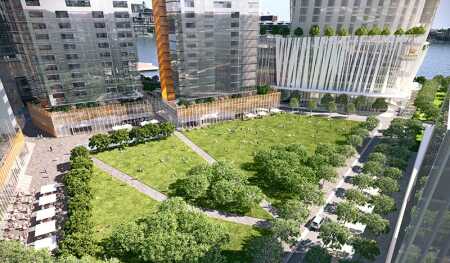A leisurely ten-minute walk from the Sydney Harbour Bridge, Barangaroo—the city’s newest landmark—is redefining sustainable development. Barangaroo is the AUS$8 billion (US$5.8 billion) waterfront renewal project transforming a long-neglected part of Sydney’s central business district. It is also the city’s largest urban renewal project since the Olympic Games 15 years ago. After decades of being closed off to the public and years of contentious debate about its future, the western edge of Sydney Harbour is being brought back to life.
The ambitious development is divided into three areas: Barangaroo Reserve, built by Lendlease Engineering; Central Barangaroo, the cultural heart of the precinct with a future train station; and Barangaroo South, its economic powerhouse, which is being developed by Lendlease. In keeping with the original design principles for the site, more than half of the Barangaroo precinct will be open public space on completion in 2021.
Aside from the pioneering scale of urban regeneration, Barangaroo is also breaking ground in sustainable development. “Many people talk about innovation, but at Barangaroo South, there is a constant desire to push the envelope and do something extraordinary,” says Andrew Wilson, Lendlease’s managing director of Barangaroo South.
Aiming to be one of the world’s leading sustainable urban developments and Australia’s first large-scale carbon-neutral community, Barangaroo is committed to reduce the embodied carbon in the development by 20 percent. Australia’s unique weather patterns and vulnerability to climate change have been at the forefront of Barangaroo’s design. For Rowan Griffin, Lendlease’s head of sustainability for investment management, taking account of this issue is a critical factor in the strength of the Barangaroo project as an asset. “Allowing for future weather events makes good investment sense,” he said.
The project’s energy-efficient design is supported by low-carbon and renewable energy. Smarter buildings, which are designed to perform better, will target the highest available Green Star and National Australian Built Environment Rating System ratings. Precinct-wide infrastructure for power, cooling, and water and waste management provides for greater efficiencies and economies of scale. Rainwater from 23,775-gallon (90,000 l) tanks in each of the commercial towers will be used for irrigation of landscaped areas. As Australia seeks to make itself drought-proof, the objective for Barangaroo is to be “water positive,” which means exporting more recycled water than the potable water it uses on site.
Halfway through the ten-year building process, Barangaroo Reserve opened in August, marking the transformation of one of the city’s oldest and ugliest industrial sites into a spectacular, 15-acre (6 ha) headland open space. The entire reserve has been developed to showcase Sydney as a world leader in innovative sustainability. Using innovative, industry-first technology, renowned father and son landscape architects Peter and David Walker wanted to create a “naturalistic” park of brand-new bushland.
The concept behind the design was the reimagination of what the land would have looked like when the Aboriginal Gadigal people still lived there. Planted were 75,000 native plants, from 83 species of trees and shrubs. “It’s made out of plants that are native, not to Australia but native to Sydney,” said Peter Walker. This month, the architects won the prestigious New South Wales President’s Award, which recognizes outstanding landscape architecture.
Developed by multinational property company Lendlease, Barangaroo South is the commercial side of the development and will be a vibrant new waterfront financial district, with a mix of world-class office space, premium residential buildings, and shopping, dining, hotel, hospitality, and public places. The 18.5-acre (7.5 ha) development is made up of three commercial towers that are being marketed as an upcoming financial and professional hub for the Asia Pacific region.
One of the towers—T2—is now complete, with one of Australia’s top four banks, Westpac, occuping 646,000 square feet (60,000 sq m) of office space. Later this year, the three residential towers designed by Renzo Piano, the acclaimed Italian architect behind the Shard in London, will start to open, while the remaining two office towers will be finished in 2016 and 2017; Lendlease, HSBC, PwC, Swiss RE, Marsh McLennan and Companies, and KPMG are locked in as tenants. To date, Tower 2 and Tower 3 have been awarded 6-Star Green Star Office Design v3 ratings by the Green Building Council of Australia, making them Australia’s most sustainable high-rise office buildings. A new landmark hotel is also proposed, and the waterfront will have a wide range of retail and dining outlets, including, for the first time outside its native Copenhagen, world-famous restaurant Noma Australia, which is relocating to Sydney for a ten-week residency.
The precinct will eventually be home to around 1,800 residents and 23,000 office workers and will contribute an estimated AUS$2 billion (US$1.4 billion) every year to the local economy.
Lendlease wants Barangaroo South to serve not only as the poster child for green buildings now, but also as a blueprint for developments in the future. “There’s little doubt that Barangaroo South is acting as a beacon to other developers and cities, to show what can be done in terms of sustainability,” said Anita Mitchell, general manager, sustainability, at Barangaroo South. “Suppliers are starting to offer the market solutions we have piloted with them at Barangaroo. Some now offer a carbon-neutral product or an embodied-carbon assessment of what they produce based on what they have learned through working with us. It is this genuine change that will be one of the many lasting effects Barangaroo has on our industry,” she added.





